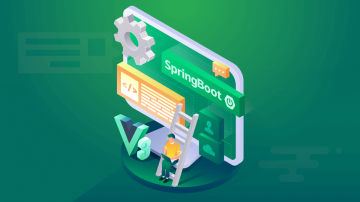本文详细介绍了Springboot企业级开发学习的相关内容,从基础入门到高级特性的全面解析,帮助开发者快速搭建和优化项目。文章涵盖了SpringBoot的自动配置、依赖管理和RESTful API设计等核心概念,并深入讲解了安全认证、日志管理和高可用配置等企业级特性。此外,通过实战案例详解了用户管理系统和商品信息展示系统的开发过程,提供了丰富的部署与发布指导。
Springboot企业级开发学习:从入门到初级实战指南 SpringBoot基础入门SpringBoot简介
SpringBoot是由Pivotal团队提供的框架,是Spring生态系的一部分,主要目标是简化Spring应用的初始搭建以及开发过程。SpringBoot通过提供一系列默认配置帮助开发者快速搭建项目,减少配置文件的编写。它允许开发者通过Spring Boot来创建独立的、生产级别的基于Spring框架的应用程序。
SpringBoot的特点包括:
- 自动配置:通过一系列默认配置帮助开发者快速搭建项目。
- 起步依赖:减少了手动配置的步骤,通过在
pom.xml或build.gradle文件中添加起步依赖,SpringBoot会自动引入所需的依赖。 - 内嵌Web服务器:SpringBoot可以内嵌Tomcat、Jetty或Undertow作为Web服务器。
- 支持数据库集成:支持多种数据库,如MySQL、PostgreSQL,并通过JDBC、JPA等技术进行操作。
- 全面的文档:SpringBoot提供了详细的文档,包括官方指南和开发文档。
- 无代码生成:不需要额外的代码生成器或XML配置,减少了开发复杂度。
- 方便的外部化配置:支持在不同环境中配置不同的属性,如使用不同的配置文件。
- Actuator:提供了一系列的生产特性,如健康检查、信息暴露等。
快速搭建SpringBoot项目
要开始一个SpringBoot项目,可以使用Spring Initializr或Spring Boot CLI来快速搭建项目。这里以使用Spring Initializr为例。要使用Spring Initializr,可以访问其官方网站,选择需要的依赖,下载生成的项目文件,然后导入到IDE中进行开发。
使用Spring Initializr搭建SpringBoot项目的基本步骤如下:
- 访问Spring Initializr官网。
- 选择项目类型(例如Maven项目或Gradle项目)。
- 选择Java版本。
- 输入项目基本信息,如项目名称、包名等。
- 选择需要的依赖,如Web、JPA等。
- 下载项目文件。
- 使用IDE打开项目。
示例代码(pom.xml):
<project xmlns="http://maven.apache.org/POM/4.0.0" xmlns:xsi="http://www.w3.org/2001/XMLSchema-instance"
xsi:schemaLocation="http://maven.apache.org/POM/4.0.0 http://maven.apache.org/xsd/maven-4.0.0.xsd">
<modelVersion>4.0.0</modelVersion>
<groupId>com.example</groupId>
<artifactId>demo</artifactId>
<version>0.0.1-SNAPSHOT</version>
<parent>
<groupId>org.springframework.boot</groupId>
<artifactId>spring-boot-starter-parent</artifactId>
<version>2.3.4.RELEASE</version>
</parent>
<dependencies>
<dependency>
<groupId>org.springframework.boot</groupId>
<artifactId>spring-boot-starter-web</artifactId>
</dependency>
<dependency>
<groupId>org.springframework.boot</groupId>
<artifactId>spring-boot-starter-data-jpa</artifactId>
</dependency>
<dependency>
<groupId>org.springframework.boot</groupId>
<artifactId>spring-boot-starter-test</artifactId>
<scope>test</scope>
</dependency>
</dependencies>
<build>
<plugins>
<plugin>
<groupId>org.springframework.boot</groupId>
<artifactId>spring-boot-maven-plugin</artifactId>
</plugin>
</plugins>
</build>
</project>依赖管理和自动配置
SpringBoot简化了依赖管理和配置过程。依赖管理通过pom.xml或build.gradle文件中的起步依赖来完成。起步依赖包含了常用的依赖,例如Spring Web、Spring Data JPA等,可以自动引入所需的库,减少配置。
在pom.xml文件中,我们可以通过添加起步依赖来引入所需的库。例如,引入Spring Web和Spring Data JPA的起步依赖:
<dependency>
<groupId>org.springframework.boot</groupId>
<artifactId>spring-boot-starter-web</artifactId>
</dependency>
<dependency>
<groupId>org.springframework.boot</groupId>
<artifactId>spring-boot-starter-data-jpa</artifactId>
</dependency>这些依赖会自动引入所需的库,减少配置文件的编写。此外,SpringBoot还提供了自动配置功能,通过检查类路径中的库并自动配置Spring组件。
示例代码(启动类):
package com.example.demo;
import org.springframework.boot.SpringApplication;
import org.springframework.boot.autoconfigure.SpringBootApplication;
@SpringBootApplication
public class DemoApplication {
public static void main(String[] args) {
SpringApplication.run(DemoApplication.class, args);
}
}MVC架构理解
MVC(Model-View-Controller)是SpringBoot中最常见的架构模式之一。MVC模型将应用程序分为三个核心模块:Model、View、Controller。
- Model:模型层主要负责数据的处理与业务逻辑的实现。通常使用JavaBean或POJO类来表示数据模型。
- View:视图层是用户交互的界面,用户可以在此查看数据。在SpringBoot中,视图层可以使用JSP、Thymeleaf、Freemarker等多种模板引擎。
- Controller:控制器层负责处理用户的请求和调用相应的服务来完成业务逻辑。控制器层与视图层进行交互,接收用户的请求,调用相应的服务来完成业务逻辑,最后返回视图层。
示例代码(Controller):
package com.example.demo;
import org.springframework.web.bind.annotation.GetMapping;
import org.springframework.web.bind.annotation.RestController;
@RestController
public class HelloWorldController {
@GetMapping("/hello")
public String hello() {
return "Hello, World!";
}
}RESTful API设计
REST(Representational State Transfer)是一种设计风格,它通过HTTP协议来实现分布式系统的架构。RESTful API设计的优点在于它简单明了,易于理解和扩展。
在SpringBoot中,可以通过注解来定义RESTful API,例如@RestController、@GetMapping、@PostMapping、@PutMapping、@DeleteMapping等。
RESTful API设计的基本原则包括:
- 资源识别:每一个URL都是一个资源。
- 统一接口:通过使用标准的HTTP方法(GET、POST、PUT、DELETE)来操作资源。
- 无状态性:每个请求都应包含所有必需的信息,服务器端不应保存客户端的状态。
- 分层系统:客户端和服务器之间可以通过中间层来交互。
示例代码(RESTful API):
package com.example.demo;
import org.springframework.http.ResponseEntity;
import org.springframework.web.bind.annotation.*;
@RestController
@RequestMapping("/api/users")
public class UserController {
@GetMapping("/{id}")
public ResponseEntity<User> getUser(@PathVariable Long id) {
// 获取用户逻辑
User user = getUserById(id);
return ResponseEntity.ok(user);
}
@PostMapping("/")
public ResponseEntity<User> createUser(@RequestBody User user) {
// 创建用户逻辑
User newUser = createUser(user);
return ResponseEntity.status(HttpStatus.CREATED).body(newUser);
}
}数据库集成与操作
SpringBoot支持多种数据库集成,如MySQL、PostgreSQL、Oracle等。通过JDBC、JPA等技术可以进行数据库操作。这里以JPA为例进行说明。
JPA(Java Persistence API)是一种Java持久化规范,它允许开发者使用注解的方式来进行数据库操作。SpringBoot通过Spring Data JPA来简化了JPA的使用。
配置数据库连接:
spring:
datasource:
url: jdbc:mysql://localhost:3306/testdb
username: root
password: root
driver-class-name: com.mysql.cj.jdbc.Driver定义实体类:
package com.example.demo;
import javax.persistence.Entity;
import javax.persistence.GeneratedValue;
import javax.persistence.GenerationType;
import javax.persistence.Id;
@Entity
public class User {
@Id
@GeneratedValue(strategy = GenerationType.IDENTITY)
private Long id;
private String name;
private String email;
// Getter and Setter methods
}定义Repository接口:
package com.example.demo;
import org.springframework.data.jpa.repository.JpaRepository;
public interface UserRepository extends JpaRepository<User, Long> {
}示例代码(服务层):
package com.example.demo;
import org.springframework.beans.factory.annotation.Autowired;
import org.springframework.stereotype.Service;
@Service
public class UserService {
@Autowired
private UserRepository userRepository;
public User getUser(Long id) {
return userRepository.findById(id).orElse(null);
}
public User createUser(User user) {
return userRepository.save(user);
}
}安全认证与授权
SpringBoot提供了多种安全认证与授权的解决方案,如Spring Security等。Spring Security是Spring的一个安全框架,它通过过滤器链来保护应用程序的安全性。
要使用Spring Security,可以在项目中添加起步依赖:
<dependency>
<groupId>org.springframework.boot</groupId>
<artifactId>spring-boot-starter-security</artifactId>
</dependency>示例代码(安全配置):
package com.example.demo;
import org.springframework.context.annotation.Bean;
import org.springframework.context.annotation.Configuration;
import org.springframework.security.config.annotation.web.builders.HttpSecurity;
import org.springframework.security.config.annotation.web.configuration.EnableWebSecurity;
import org.springframework.security.config.annotation.web.configuration.WebSecurityConfigurerAdapter;
import org.springframework.security.core.userdetails.User;
import org.springframework.security.core.userdetails.UserDetails;
import org.springframework.security.core.userdetails.UserDetailsService;
import org.springframework.security.provisioning.InMemoryUserDetailsManager;
@Configuration
@EnableWebSecurity
public class SecurityConfig extends WebSecurityConfigurerAdapter {
@Override
protected void configure(HttpSecurity http) throws Exception {
http
.authorizeRequests()
.antMatchers("/login/**").permitAll()
.anyRequest().authenticated()
.and()
.formLogin()
.loginPage("/login")
.permitAll()
.and()
.logout()
.permitAll();
}
@Override
@Bean
public UserDetailsService userDetailsService() {
UserDetails user = User.withDefaultPasswordEncoder()
.username("user")
.password("password")
.roles("USER")
.build();
return new InMemoryUserDetailsManager(user);
}
}日志管理与监控
SpringBoot通过Spring Boot Actuator提供了丰富的生产特性,包括健康检查、信息暴露、日志管理等。Actuator允许开发者通过HTTP端点来监控应用的运行状态。
要使用Actuator,可以在项目中添加起步依赖:
<dependency>
<groupId>org.springframework.boot</groupId>
<artifactId>spring-boot-starter-actuator</artifactId>
</dependency>示例代码(启用Actuator):
management:
endpoints:
web:
exposure:
include: "*"高可用与负载均衡配置
SpringBoot可以通过配置来实现高可用和负载均衡。例如,可以使用Spring Cloud Netflix的Eureka来实现服务发现和负载均衡。Eureka是一个基于REST的服务注册与发现框架,它允许服务实例进行注册和发现。
要使用Eureka,可以在项目中添加起步依赖:
<dependency>
<groupId>org.springframework.cloud</groupId>
<artifactId>spring-cloud-starter-netflix-eureka-client</artifactId>
</dependency>示例代码(Eureka客户端配置):
package com.example.demo;
import org.springframework.boot.SpringApplication;
import org.springframework.boot.autoconfigure.SpringBootApplication;
import org.springframework.cloud.netflix.eureka.EnableEurekaClient;
@SpringBootApplication
@EnableEurekaClient
public class DemoApplication {
public static void main(String[] args) {
SpringApplication.run(DemoApplication.class, args);
}
}用户管理系统搭建
用户管理系统是一个典型的Web应用,包括用户注册、登录、个人信息管理等功能。这里以用户注册和登录为例进行说明。
示例代码(用户实体类):
package com.example.demo;
import javax.persistence.Entity;
import javax.persistence.GeneratedValue;
import javax.persistence.GenerationType;
import javax.persistence.Id;
@Entity
public class User {
@Id
@GeneratedValue(strategy = GenerationType.IDENTITY)
private Long id;
private String username;
private String password;
// Getter and Setter methods
}示例代码(用户服务层):
package com.example.demo;
import org.springframework.beans.factory.annotation.Autowired;
import org.springframework.security.crypto.password.PasswordEncoder;
import org.springframework.stereotype.Service;
@Service
public class UserService {
@Autowired
private UserRepository userRepository;
@Autowired
private PasswordEncoder passwordEncoder;
public User register(User user) {
user.setPassword(passwordEncoder.encode(user.getPassword()));
return userRepository.save(user);
}
public User login(String username, String password) {
User user = userRepository.findByUsername(username);
if (user != null && passwordEncoder.matches(password, user.getPassword())) {
return user;
}
return null;
}
}示例代码(登录和注册控制器):
package com.example.demo;
import org.springframework.beans.factory.annotation.Autowired;
import org.springframework.web.bind.annotation.*;
@RestController
public class UserController {
@Autowired
private UserService userService;
@PostMapping("/register")
public String register(@RequestBody User user) {
userService.register(user);
return "Registration successful";
}
@PostMapping("/login")
public String login(@RequestBody User user) {
User loggedUser = userService.login(user.getUsername(), user.getPassword());
if (loggedUser != null) {
return "Login successful";
} else {
return "Invalid credentials";
}
}
}商品信息展示系统开发
商品信息展示系统是一个典型的数据展示系统,包括商品分类、商品列表、商品详情等功能。这里以商品列表为例进行说明。
示例代码(商品实体类):
package com.example.demo;
import javax.persistence.Entity;
import javax.persistence.GeneratedValue;
import javax.persistence.GenerationType;
import javax.persistence.Id;
@Entity
public class Product {
@Id
@GeneratedValue(strategy = GenerationType.IDENTITY)
private Long id;
private String name;
private String description;
private double price;
// Getter and Setter methods
}示例代码(商品服务层):
package com.example.demo;
import org.springframework.beans.factory.annotation.Autowired;
import org.springframework.stereotype.Service;
import java.util.List;
@Service
public class ProductService {
@Autowired
private ProductRepository productRepository;
public List<Product> getAllProducts() {
return productRepository.findAll();
}
}示例代码(商品展示控制器):
package com.example.demo;
import org.springframework.beans.factory.annotation.Autowired;
import org.springframework.web.bind.annotation.GetMapping;
import org.springframework.web.bind.annotation.RequestMapping;
import org.springframework.web.bind.annotation.RestController;
import java.util.List;
@RestController
@RequestMapping("/api/products")
public class ProductController {
@Autowired
private ProductService productService;
@GetMapping("/")
public List<Product> getAllProducts() {
return productService.getAllProducts();
}
}文件上传与下载功能实现
文件上传与下载功能通常用于Web应用中,可以让用户上传和下载文件。这里以文件上传为例进行说明。
示例代码(文件上传控制器):
package com.example.demo;
import org.springframework.stereotype.Controller;
import org.springframework.web.bind.annotation.PostMapping;
import org.springframework.web.bind.annotation.RequestParam;
import org.springframework.web.multipart.MultipartFile;
import java.io.File;
import java.io.IOException;
@Controller
public class FileUploadController {
@PostMapping("/upload")
public String handleFileUpload(@RequestParam("file") MultipartFile file) {
try {
File uploadDir = new File(System.getProperty("user.dir") + "/upload");
if (!uploadDir.exists()) {
uploadDir.mkdirs();
}
File uploadedFile = new File(uploadDir, file.getOriginalFilename());
file.transferTo(uploadedFile);
} catch (IOException e) {
e.printStackTrace();
}
return "File uploaded successfully!";
}
}示例代码(文件下载控制器):
package com.example.demo;
import org.springframework.core.io.FileSystemResource;
import org.springframework.http.HttpHeaders;
import org.springframework.http.MediaType;
import org.springframework.http.ResponseEntity;
import org.springframework.web.bind.annotation.GetMapping;
import org.springframework.web.bind.annotation.RequestMapping;
import org.springframework.web.bind.annotation.RestController;
import java.io.File;
@RestController
@RequestMapping("/api/files")
public class FileDownloadController {
@GetMapping("/{filename:.+}")
public ResponseEntity<FileSystemResource> downloadFile(@PathVariable String filename) {
File file = new File(System.getProperty("user.dir") + "/upload/" + filename);
return ResponseEntity.ok().header(HttpHeaders.CONTENT_DISPOSITION, "attachment; filename=" + file.getName())
.contentType(MediaType.APPLICATION_OCTET_STREAM)
.body(new FileSystemResource(file));
}
}典型错误排查与解决方案
在开发SpringBoot项目时,可能会遇到各种错误,例如依赖冲突、配置错误等。这些问题可以通过查看控制台输出、日志文件等来排查。
示例代码(依赖冲突排查):
<dependency>
<groupId>org.springframework.boot</groupId>
<artifactId>spring-boot-starter-web</artifactId>
<exclusions>
<exclusion>
<groupId>org.springframework.boot</groupId>
<artifactId>spring-boot-starter-tomcat</artifactId>
</exclusion>
</exclusions>
</dependency>性能优化与调优技巧
性能优化是提高应用性能的重要手段。SpringBoot提供了一些配置选项来优化应用的性能,例如通过配置连接池来提高数据库访问速度、通过配置缓存来减少数据库访问次数等。
示例代码(连接池配置):
spring:
datasource:
hikari:
maximum-pool-size: 20
minimum-idle: 10
connection-timeout: 30000部署与发布流程详解
部署与发布是将应用部署到生产环境的重要步骤。SpringBoot提供了一种简便的部署方式,即打包成可执行的JAR文件,然后运行该JAR文件即可启动应用。
示例代码(打包与运行):
mvn clean package
java -jar target/myapp.jar使用Docker部署示例
version: '3'
services:
app:
image: myapp:latest
ports:
- "8080:8080"
environment:
- SPRING_PROFILES_ACTIVE=prod
- SPRING_DATASOURCE_URL=jdbc:mysql://db:3306/app?useUnicode=true&characterEncoding=utf8&useSSL=false
depends_on:
- db
db:
image: mysql:5.7
environment:
- MYSQL_ROOT_PASSWORD=root
- MYSQL_DATABASE=app开发文档与官方教程
SpringBoot的官方文档提供了详细的开发指南,包括入门指南、核心概念、高级配置等。开发者可以在SpringBoot官网(https://spring.io/projects/spring-boot)获取官方文档。
开源项目与社区资源
SpringBoot项目的GitHub仓库中提供了大量的示例代码和实用工具。开发者可以访问SpringBoot的GitHub仓库(https://github.com/spring-projects/spring-boot)来获取资源。
在线课程与书籍推荐
推荐编程学习网站可以推荐慕课网,这里提供了大量的SpringBoot在线课程,开发者可以根据自己的需求选择适合的课程进行学习。

 随时随地看视频
随时随地看视频




